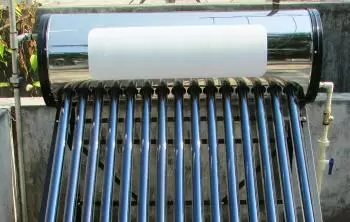
A solar accumulator is a solar tank that stores hot water from a solar thermal installation is stored. This device aims to store heat energy.
The production of hot water through solar energy is slow. Therefore, it is necessary to have a solar water heater tank to store the most significant amount of hot water for when it is needed. For example, domestic hot water (DHW) may be required during night hours, but solar radiation is not available to heat it.
Solar thermal energy is a renewable energy source that transforms sunlight into heat energy. It is helpful for many uses, but one is to generate hot water for homes. Depending on the system chosen, we can use flat plate collectors or evacuated tubes to heat water.
In this sense, solar water tanks store the heated water generated during the day, ready to be used when needed. This system will help us to reduce our electricity bills since we won’t need to use electricity to heat water.
Components of a solar water tank
A solar accumulator consists of a metal tank made from synthetic material or stainless steel. In addition, a high-quality solar water heater tank must be well insulated - typically with PUF insulation - to avoid heat losses.
The solar water tank incorporates one or two heat exchangers into its installation. These exchangers allow you to maximize your safety to avoid the risk of leaks and thermodynamic energy loss.
How does a solar water tank work?

The secondary circuit is open. It has a cold water inlet (A) and a hot water outlet (E), which will be used in our heating or domestic hot water system.
Cold water enters the solar storage tank (B) as it empties when consumed. Cold water is slightly denser than hot water, so it tends to settle at the bottom of the tank. Therefore, it will be drawn from the top when hot water is needed.
The liquid from the primary circuit passes through the solar collectors that heat it thanks to exposure to solar radiation (D) and goes to a heat exchanger with the liquid from the solar water tank.
In the heat exchanger, the two liquids are in thermal contact, but they do not mix since they form a diathermic wall. According to the second law of thermodynamics, heat can only be transferred from a hot body to a cold body, which is the storage liquid.
Importance of the heat exchanger
A system that did not use a heat exchanger and the water that entered the collectors was the same as that stored in the tank would also work.
However, the efficiency of heat transmission in a thermodynamic system is proportional to the temperature difference. In other words, the colder the liquid passes through the solar collector, the faster it will heat up.
Horizontal or vertical orientation?
Suppose the solar water tank is in a vertical position. In that case, the temperature stratification is carried out more quickly and effectively, so the entire tank doesn't need to be at the set temperature.
In addition, when the solar accumulator is installed in a vertical position, more excellent thermal performance of the solar collectors is obtained, and thermal losses are again avoided.
Types of solar water tanks
The solar installation size is the most critical element in choosing one type of solar water tank.
Depending on the size of the installation
For small or medium-sized structures, it is common for the tank itself to also contain the drinking water.
On the other hand, in large and complex solar thermal energy installations, other intermediate buffer tanks must be gradually established. The buffer tanks allow the thermal energy to be stored, which will later be transferred to the solar accumulator.
Most usual solar water tank sizes go from 120 to 300 liters. The first one suits the needs of two or three people; meanwhile, a 200 liter solar water heater can serve about eight people.
Internal or external exchangers
Furthermore, we can obtain other variants depending on whether the heat exchangers are external or located inside the condenser.
The water is heated outside if the tank does not have a built-in exchanger. On the other hand, if it is included inside, water accumulation and its subsequent temperature increase occur within the same tank.
Depending on the location
The solar tank can be:
-
Above the solar collectors
-
At another site in the facility.
If they are above, it is a thermosyphon solar system; the fluid that circulates between the solar collectors and the accumulator does not require pumping.
If, on the other hand, the accumulator is located elsewhere, an input of electrical energy is required to pump the fluid. In these cases, the power supplied can come from another renewable energy source or directly from the electricity grid.